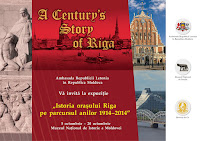The goal of the exhibition is, alongside important events in Europe, to reflect the events of the same time period in Riga; by means of various pictures and their combinations, to touch upon the themes of war and freedom as well as the outstanding personalities of the time, with the aim of showing the various, open, and multi-faceted Riga. The exhibition is formed and reflected by juxtapositions of various tendencies; fashion, architecture, design, music and other spheres and events of culture.
Motto of the exhibition: "The Phoenix of Riga"
Riga is similar to the Phoenix in Ancient Greek mythology - the bird that after burning has always been able to resurrect from ashes. Over one century, Riga has seen seven changes of the ruling power:
- Tsarist Russia;
- the German Kaiser;
- "red" Soviet Latvia and "white" Republic of Latvia;
- USSR occupation and Nazi Third Reich;
- Soviet occupation again
- up to the restoration of an independent Republic of Latvia.
Riga saw the evacuation of its factories in 1915, which diminished its population by a half; it saw the attacks of the Bermondt army, which left the quay of the river Daugava in ruins. The agrarian reform in the 1920s gave the city land property and made it possible to dream about the construction of an enlarged city with one million inhabitants. The devastation of Old Riga in 1941 was followed by restoration after the war, the city expanded into the former pastures and kitchen gardens, building new residential areas. The present-day Riga is proud of its cultural heritage.
The exhibition shows the impact of a series of events, which have taken place in Europe of the 20th century, over the history of Latvians, the impact that has resulted in the loss of independence of the Republic of Latvia. The major events - the wars and revolutions - are illustrated by panels with black-and-white and red fragments of historical photographs. The removal of ruins and the new construction to start everything from scratch is illustrated by the history of two nodal points - the City Hall Square and the Citadel. City scenes will be supplemented with information on everyday life: how the ordinary Rigan lived, what he ate, how he worked and recreated himself...
The pictures will show the flourishing Riga after World War I, the burning Riga in 1941, Soviet Riga, the Barricade Time and the 20 years of restored independence. We will stress Riga's ability to always resurrect as the Phoenix from ashes.


















































